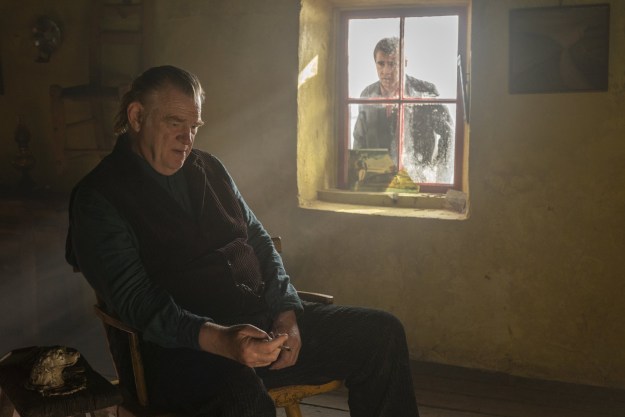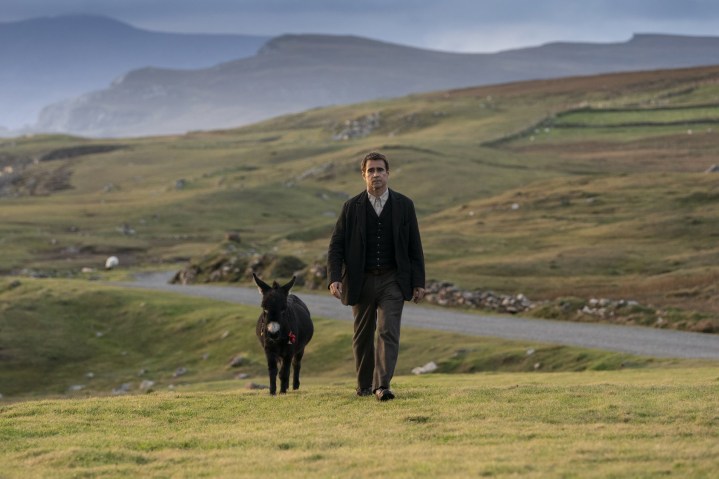
“The Banshees of Inisherin is not only the year’s greatest breakup film, but also an appropriately thorny follow-up to In Bruges, the acclaimed drama that first brought Gleeson, Farrell, and McDonagh together.”
- Martin McDonagh's unpredictable, emotionally involving script
- Colin Farell's career-best performance
- Brendan Gleeson, Barry Keoghan, and Kerry Condon's stunning supporting performances
- Slightly too long
- A few too many tourist ad-esque shots of Ireland
- An ending that may be too ambiguous for some viewers
Early on in The Banshees of Inisherin, the brilliant new film from writer-director Martin McDonagh, Siobhán (Kerry Condon) asks her brother, Pádraic (Colin Farrell), a question that’s clearly been on her mind for a long time. “Do you ever get lonely, Pádraic?” she asks. “Do I ever get lonely? Do I ever get lonely? What is with everyone today?” Pádraic responds shortly before storming out of the room. He, notably, doesn’t answer Siobhán’s question. Maybe it’s because he doesn’t know how to answer it. Or maybe it’s because the answer is obvious — so obvious, in fact, that there’s no point in even asking. Of course, Pádraic gets lonely. Who wouldn’t be on a small Irish island like Inisherin?
For Pádraic, the inherent loneliness of his home has largely been kept at bay by one thing: his long-standing friendship with Colm Doherty (Brendan Gleeson), a talented violinist. Pádraic’s life is turned upside down, however, when Colm decides at the start of The Banshees of Inisherin that he no longer wants to be friends with Farrell’s oblivious, simple-minded farmer. The decision, which is born out of seemingly nothing more than Colm’s own dissatisfaction with his life, forces both he and Pádraic to face the parts of themselves and their lives that they’ve either never noticed or long chosen to ignore.
What emerges from these reckonings is not only the year’s greatest breakup film, but also an appropriately thorny follow-up to In Bruges, the acclaimed drama that first brought Gleeson, Farrell, and McDonagh together. Here, in his latest outing, McDonagh uses the disintegration of a single friendship to touch on everything from the Irish Civil War to the ways in which mental illness often affects not just one person, but those they love as well. Not since their previous collaboration have Gleeson, McDonagh, and Farrell dealt with such emotionally visceral, delicate material, but all three emerge from The Banshees of Inisherin more accomplished than they were before.
Breaking up is hard to do

Set in the early 1920s, The Banshees of Inisherin takes place during a time when Ireland is still in the midst of its infamous civil war. Despite that fact, the only signs of war that ever seem to reach the residents of The Banshees of Inisherin‘s central island are the occasional booms of canons and the thin pillars of smoke that can be seen from across the sea. While these traces of bloodshed linger ominously in the air as well, the violence of the war itself has, nonetheless, not yet come to the shores of the film’s eponymous island when The Banshees of Inisherin begins.
That all changes when Gleeson’s Colm decides to terminate his friendship with Farrell’s Pádraic. The latter, understandably, doesn’t take Colm’s decision well. However, when Pádraic repeatedly demands to hear a reasonable explanation for his friend’s change of attitude, Colm comes up with a brutal ultimatum: Every time Pádraic bothers Colm, he will cut off one of his own fingers. The only way for Pádraic to avoid bloodshed is, therefore, to totally cut himself off from Colm.
Like so many of McDonagh’s best dramatic inventions, Colm’s ultimatum pulses with the threat of both inward and outward violence. McDonagh, for his part, never outright explains the feelings and thoughts that led Gleeson’s Colm to such a bitter, violent mental space, either. The writer, instead, lets Colm’s actions speak for themselves, and his decision to threaten to harm himself instead of Farrell’s Padraic ultimately tells us everything we need to know about Colm’s personal issues.
A pair of terrific lead performances

Both Colm and Pádraic are, in many ways, sketched very thinly by McDonagh. In the hands of lesser performers, they might have even come across as one-note. While Gleeson and Farrell don’t, by any means, paint outside the lines of McDonagh’s original sketches, either, they do fill them up with enough color to turn both Colm and Pádraic into two of the most memorable characters you’ll likely see on-screen this year.
McDonagh’s familiarity with Gleeson and Farrell also allows him to play to each of their strengths. Gleeson’s ability to seem composed even in the face of absolute chaos has, for instance, helped him hone a uniquely commanding screen presence over the years. Here, however, Gleeson’s steadfast composure is used to devastating effect once it becomes clear that Colm’s assured, calm demeanor is nothing more than a thin veil meant to cover up his own sense of wayward hopelessness. Opposite him, Colin Farrell taps into the same kind of emotional volatility that McDonagh spotlighted when they worked together nearly 15 years ago on In Bruges.
In a sense, Farrell’s turn in The Banshees of Inisherin even feels like an inverse of his In Bruges performance. That 2008 drama saw Farrell play a character whose initial harshness and cruelty eventually fell away to reveal the depression and guilt that had been tormenting him all along. Here, in The Banshees of Inisherin, Pádraic’s innocence is gradually chipped away until all that remains is his own bitterness and anger. The character’s transformation is alternatively heartbreaking and horrifying to watch, and Farrell makes the most of it, turning in a performance that might very well be the best of his career so far.
A fully realized Irish world

Outside of Gleeson and Farrell, Kerry Condon and Barry Keoghan turn in two stunning performances as The Banshees of Inisherin‘s primary supporting figures. As Siobhán, Pádraic’s sister, Condon serves as the steady, sole voice of reason amid the growing chaos caused by Colm and her brother’s unnecessary feud. Keoghan, meanwhile, cements himself yet again as one of Hollywood’s most exciting young performers with his turn as Dominic, a town pariah whose brash personality has created a painful divide between him and many of Inisherin’s other residents.
Together, Keoghan, Condon, Farrell, and Gleeson breathe real life into The Banshees of Inisherin’s isolated and humorous, if often melancholic, world. As a film about two friends who are suddenly and violently ripped apart by their own hang-ups, McDonagh’s latest is, much like the characters within it, a heart-wrenching, relentlessly honest piece of work. It’s not just Colm and Pádraic’s friendship that McDonagh has on his mind in The Banshees of Inisherin, though.
While Inisherin itself may seem to exist in its own little world, McDonagh makes it clear that the island isn’t free of the same problems that have plagued humanity for centuries. That point is never better made than in The Banshees of Inisherin‘s third act when McDonagh briefly shows Farrell’s Pádraic watching silently as distant pillars of smoke billow up into the air. They look strikingly similar to the ones that Pádraic saw near the start of the film, but unlike those, which belonged to Ireland’s mainland, these new plumes of smoke are coming from the same space as a nearby Inisherin homestead. Violence, it turns out, has a way of leaving its marks on even the loneliest of places.
The Banshees of Inisherin hits theaters on Friday, October 14.
Editors' Recommendations
- Like the Best Picture Oscar nominee Killers of the Flower Moon? Then watch these 3 great films
- 3 best (HBO) Max movies you need to watch on New Year’s Day
- Rosaline review: Kaitlyn Dever lifts up Hulu’s Romeo and Juliet rom-com riff
- Amsterdam review: An exhausting, overlong conspiracy thriller
- Tár review: Cate Blanchett soars in Todd Field’s ambitious new drama




